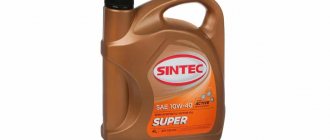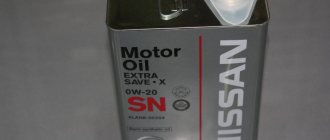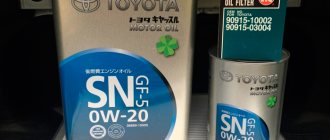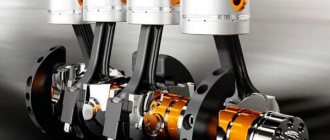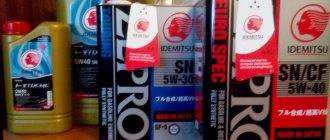The main purpose of motor lubricants is to protect engine elements from dry friction and ensure normal operation of the power unit while maintaining the tightness of the cylinders. With the correct selection of oil, the engine functions properly for a long time. 5W30 oil is the most popular among synthetic types of lubricants of famous brands.
Description of domestic lubricants
The largest domestic manufacturers of lubricating fluids Rosneft and Lukoil guarantee the high quality of their oil products. Synthetic motor oil 5 W 30, produced here, is included in an acceptable price category; this lubricant is perfectly suited for the operation of many types of power units in domestic climatic conditions.
5W30 motor oils made in Russia are also successfully used at high ambient temperatures, which is acceptable for use in warm latitudes.
Temperature features
In most cases, modern manufacturers of automobile oils allow their operation at temperatures no more than minus 20 degrees Celsius. If you live in such a climate, it is not important for you to choose between 15W-40 and 5W-30 oils. The decoding of both allows operation even in the harshest winter. However, if your starter/battery is very worn/discharged, it is better to give preference to 5W-30 or 0W-30 oil. The lower the viscosity, the greater the chance that your starter will crank the engine and start it “cold”.
What do the symbols on the engine oil label mean?
When purchasing lubricating fluids, buyers wonder what the meaning of 5W30 is, what kind of information is contained in the inscription, and what type of product to give preference to. Deciphering engine oil is necessary to make the correct choice of lubricant products.
SAE 5W30 stands for as follows:
- From the number 5 you need to subtract 30, the result is minus 25. A temperature of - 25˚C is acceptable for starting a cold engine.
- The letter W corresponds to the first letter of the word Winter and means the possibility of using this brand in northern latitudes.
- The number in front of W determines the speed of oil movement at high temperatures in a running engine.
- The value of the number located after W characterizes the viscosity of the oil when the engine is warm.
Due to the fact that domestic climatic conditions for operating a car differ sharply, it is necessary to select lubricants after carefully studying the labels on the product. The markings on the label correspond to the special SAE viscosity classification of oils.
This classification helps you choose the right brand of lubricant for your vehicle according to its technical characteristics, depending on the temperature conditions in which 5W30 motor oil will be used.
Explanation of oil markings
5W30, 14W-40 - such codes are found on absolutely every lubricant label. What do they mean?
In fact, any marking of such a product will include several numbers separated by the letter W and a dash. In our case, the decoding of 5w30 engine oil indicates that this fluid is all-season - the most popular among car enthusiasts. Determining all the detailed characteristics is very simple. Let's look at this using 5w30 oil as an example.
The 5W decoding tells us about the low-temperature viscosity of the product, which allows the car to cold start at a temperature of minus 35 degrees Celsius. This is determined as follows: subtract 40 from the number in front of the W value. The resulting number will be the minimum oil temperature at which the internal combustion engine pump can pump it through the system, preventing dry friction of the parts inside.
Benefits of using SAE 5W 30 grease
5W30 synthetic oil has undeniable advantages. The excellent characteristics of this material contribute to the stable operation of engines when operating in unfavorable urban conditions, which have a negative impact on engine elements:
- prolonged idling;
- finding a car in traffic jams (traffic jams);
- operating the machine over short distances;
- increased dust content in the atmosphere.
The correct selection of an oil product helps to increase the operating life of engines. Thanks to the unique formula and the presence of special additives that 5W30 motor oil has, these lubricants have properties that provide the following functions:
- protection of power unit elements from premature destruction;
- reducing the harmful effects of corrosion;
- removing layers of carbon deposits from work surfaces;
- cooling of parts and components of a running engine.
5W30 engine oil can withstand temperatures inside a working power unit of 150˚C without changing its valuable qualities. When choosing oil for the engine of a particular car, you need to be based on the recommendations contained in the technical specifications compiled by automakers.
Tolerances for the brand of motor oil are established not for a given car model, but for the engine itself.
Despite the popularity of the brand, it is necessary to choose a lubricant that has parameters that meet the requirements set forth by the manufacturer of the vehicle.
Features of the chemical composition of oil products
The additives included in SAE 30 motor oils are designed to perform strictly defined functions. Thanks to a balanced set of additional inclusions, oil fluids become suitable for use in specific engines. Each type of lubricant has additives in accordance with standard regulations for motor oils.
Which car oils to use depends on the choice of the car owner. Based on the age of the car, engine characteristics, and speed limits, the owner gives preference to a certain type of oil:
- Mineral oil.
- Synthetic or semi-synthetic.
There is an opinion that the use of mineral lubricants in cars manufactured more than five years ago leads to a reduction in oil consumption and increases the service life of the engine.
If an imported modern power unit is installed under the hood of a car, it is recommended to use synthetic types of lubricants. This series contains synthetic motor oil SAE 5W30, belonging to well-known global brands, capable of withstanding climatic changes and the intensity of traffic loads in the city.
Synthetic and semi-synthetic motor oil: main differences
In order to study in more detail the issue regarding various motor oils, it is necessary to understand what semi-synthetics and synthetics are. As you know, all motor oils have a certain base. Such a base can be mineral, semi-synthetic or completely synthetic. Next, a package of chemical additives is added to the base, which each manufacturer has its own and is a patented proprietary solution.
Let's start with synthetics, since thanks to the efforts of marketers, this is the oil that is always heard and considered the standard. Let us immediately note that this is indeed true, but with reservations. The caveat is that synthetic oil is not suitable for all types of engines, but more on that below. As the name implies, the base of synthetic oils is artificial and differs from analogues in its special molecular composition. Synthetic molecules can work for a long time in harsh conditions and withstand temperature loads, and demonstrate high resistance to chemical processes in the engine. To put it simply, the stability of all declared characteristics of the oil is maintained at different temperatures, protective and other beneficial properties are maintained over a long service life.
Synthetic oil has a stable viscosity at any temperature (even very high), allowing you to safely operate the engine in summer in various modes. As for the winter period, the pumpability of synthetic lubricant makes it easy to start the power unit in severe frosts; the material quickly reaches the loaded friction pairs through the lubrication system. It turns out that during a cold start, engine wear is reduced and the life of the unit is extended. As the engine warms up and reaches operating temperatures, optimal protection is provided. Also, synthetic oil does not create unnecessary resistance in the power plant, allowing you to save fuel. In this case, even a thin oil film is enough to prevent mechanical wear of the mating components.
If the car is used in difficult conditions (urban mode, driving at high speeds, frequent operation at idle, towing a trailer, transporting goods, etc.), and is also located in a climate zone with constant changes in average daily temperature, then synthetics deservedly become one of the the best engine oil options.
Also of particular note is the resistance of such a product to aging, oxidation and loss of properties. In other words, the longer service life of synthetic oils allows the lubricant to reliably protect the engine throughout the entire period until a scheduled lubricant change. This is especially true given the low quality of domestic fuel, which contains many impurities and additives that have a detrimental effect on motor oil. The only drawback of synthetic motor oil is its fairly high price.
Now to semi-synthetics. Semi-synthetic motor oil is part of a “natural” mineral base, to which a certain percentage of synthetic base and an additive package are added. For different manufacturers, the percentage of “mineral” and “synthetics” can vary from 30% synthetic base to 70% mineral to a 50/50 ratio. As a result, semi-synthetics are definitely better than mineral oil, but they are inferior to pure synthetics in a number of indicators and characteristics, being an intermediate link. If you ask yourself which oil is thicker, synthetic or semi-synthetic, then it becomes clear that the semi-synthetic product will be thicker due to its inclusion in the mineral base. In parallel with this advantage, one can consider a not too significant deterioration in properties while simultaneously significantly reducing the final cost of the product.
Oil fluid test
Before receiving a quality certificate, oils are tested and chemically analyzed. The labels of the canisters contain information about the compliance of the characteristics of the lubricant with the requirements of the standards. Test data is provided to inform consumers.
Oils are tested in laboratory conditions on special stands. A test is carried out to check the viscosity of the lubricant depending on the temperature inside the operating engine.
This type of diagnostic allows you to determine the possibility of starting a cold engine in cold weather and the degree of protection of the motor from overheating in hot weather. The test performed shows the thickness of the protective film formed on the rubbing surfaces of working parts and its changes as a result of an increase in the internal temperature of the engine.
The test allows consumers to become familiar with the features of lubricants produced by various manufacturers.
